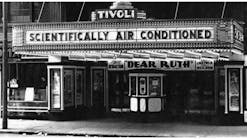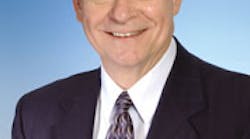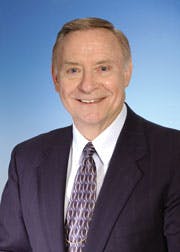Getting everything in a building to work to the designer’s intent and in accordance with the owner’s project requirements is one thing. Maintaining that level of performance is another.
Persistence in buildings has been studied for quite some time. In terms of energy-saving measures, persistence is related to “depth.” For example, changes to building control systems, such as thermostat-setting and program-schedule modifications, have low persistence (do not last long), compared with more substantial fixes, such as a lighting retrofit.
Among the keys to the persistence of HVAC performance is the cleanliness of cooling coils, drain pans, and other “wet” components. When mold, biofilm, and other organic compounds are allowed to build up:
- Indoor air experiences odors and the spread of respiratory irritants, pathogens, and allergens.
- Airflow through coils becomes restricted and fouled (lost heat transfer), deteriorating comfort and energy performance.
- Equipment and material life is shortened, and maintenance requirements increase.
Any of these outcomes threatens the “three Es” of a building’s—a green one’s in particular—bottom line: energy, efficiency, and economy.
One technology that meets the challenges of regular cleaning of wet HVAC components, as well as minimizing, if not eliminating, the use of chemicals and keeping energy and water use in check, is ultraviolet-C (UV-C) lighting.
ASHRAE Handbook—HVAC Applications suggests UV-C reduces mold and biofilm, coil pressure drop, and coil-cleaning functions without the use of chemicals. Further, it states use of UV-C can increase airflow and heat-transfer coefficient and reduce both fan- and refrigeration-system energy use. Savings of 10 to 30 percent have been reported once capacity is restored.
The UV-C wavelength easily keeps a new coil clean and degrades organic materials that have deposited on existing coil fin and tube surfaces. As a result of this cleaning action, a coil’s “open area” remains or returns to the designed performance standards. The pressure drop and velocity of the air between coil fins is optimized, while fin and tube surfaces are kept clean to maximize system heat-exchange efficiency and rate. Many original-equipment manufacturers believe UV-C could contribute to as-built capacity for the life of a system, if the UV-C technology is maintained.
Energy
According to ASHRAE, maintaining design air leaving wet-bulb temperature is fundamental to maintaining occupied spaces in the “comfort zone.” Maintaining this standard of thermal comfort is one of the most important goals of a properly designed and maintained HVAC system (ANSI/ASHRAE Standard 55, Thermal Environmental Conditions for Human Occupancy). Cooling coils reduce the absolute humidity of the air processed. The below-dew-point coil surface condenses water vapor from the recirculated air to reduce relative humidity in a conditioned space. This drier air of, typically, 40-percent to 60-percent humidity improves comfort in the occupied space. Chapter 60.8 of 2011 ASHRAE Handbook—HVAC Applications states, “By suppressing the formation of biofilms (and in the worst cases, extensive mold growth) on coils, coil irradiation should reduce airside pressure drop, increase heat transfer coefficient, and reduce both fan and refrigeration system energy consumption.”
Minor increases in air leaving wet-bulb temperature have dramatic effects on system capacity and, thus, energy costs. For example, with a 20,000-cfm system with an air entering wet-bulb temperature of 64°F and an air leaving temperature of 53°F, an increase in air leaving wet-bulb temperature of “only” 1°F results in a loss of air-conditioning capacity of 4.5 tons. Within five to 10 years, increases in air leaving temperature of 3°F are not uncommon.
Often, fan speed is increased to help compensate for lost air-conditioning capacity. However, fan horsepower increases to the “cube” of revolutions per minute. Thus, increasing fan speed consumes more energy than we realize. However, it may be enough to satisfy capacity loss temporarily. If it is not, further modifications are required.
Building engineers typically turn next to chilled-water temperature. Lowering chilled-water temperature increases the temperature differential between air and coil surfaces, increasing heat-transfer rate. The lowering of chilled-water temperature requires an increase in energy use and often is accompanied by the pumping of additional water. Increasing pump revolutions per minute has the same consequences as increasing fan revolutions per minute: a boost in horsepower to the cube of the increase.
All of the above makes an unquestionable case for keeping a coil perfectly clean.
Indoor-Air Quality (IAQ)
UV-C helps to maintain or, in a retrofit, significantly improve IAQ. The application of UV prevents the formation and reduces the dissemination of several categories of organisms that can grow and/or spread in modern air-handling systems. These include pathogens (viruses, bacteria, and fungi, which can cause a range of diseases), allergens (bacteria and mold, which can cause allergic rhinitis, asthma, humidifier fever, and hypersensitivity pneumonitis), and toxins (endotoxins and mycotoxins, which can cause a variety of toxic effects, irritation, and odors). According to both ASHRAE and the U.S. General Services Administration, UV-C energy prevents microbial “growth and transfer” into occupied spaces.
Occupant Comfort
With coils kept perfectly clean, heat-exchange efficiency and rate are maintained at as-designed values. And with microbial growth and transfer prevented, the air serving occupied spaces is not contaminated by products associated with odor-producing biomatter. Both scientific and anecdotal information is abundant in this area. Occupant surveys and comments overwhelmingly side with a clean system.
Chemicals, Drains, and Water
Chapter 60.8 of 2011 ASHRAE Handbook—HVAC Applications states: “Conventional methods for maintaining air handling system components include chemical and mechanical cleaning which can be costly, difficult to perform, and dangerous to maintenance staff and building occupants. Vapors from cleaning agents can contribute to poor air quality, chemical run off contributes to ground water contamination and mechanical cleaning can reduce component life. Furthermore, the system’s performance can begin to degrade again shortly after cleaning as microbial deposits reappear or reactivate.” The results and concerns here are not always obvious. Coil cleaning does not get the coil perfectly clean, regardless of the amount of water used. Contaminants return and, each time, additional organic material is left behind. Additionally, coil-cleaning chemicals contaminate drain waterways and air streams, which are not consistent with the green-building theme, or acceptable IAQ.
Maintenance
The use of UV-C in HVACR equipment has been shown to reduce maintenance and associated costs. According to Chapter 60.8 of 2011 ASHRAE Handbook—HVAC Applications, “Potential advantages of UV-C surface treatment includes keeping surfaces clean ‘continuously ’rather than periodically, restoring fouled surfaces, with no use of chemicals, and lower maintenance cost and, potentially, better HVAC system performance.”
Conclusion
Of all of the complex matters owners and operators of buildings face, keeping coils and drain pans clean need not be one of them.
The president of UV Resources, Forrest Fencl is the writer or co-writer of 15 patents and the author or co-author of numerous papers and articles and several ASHRAE Handbook chapters related to ultraviolet air and surface treatment. He is an ASHRAE Life Member and Fellow and a member of the International Ultraviolet Association and the Illuminating Engineering Society.
Did you find this article useful? Send comments and suggestions to Executive Editor Scott Arnold at [email protected].










